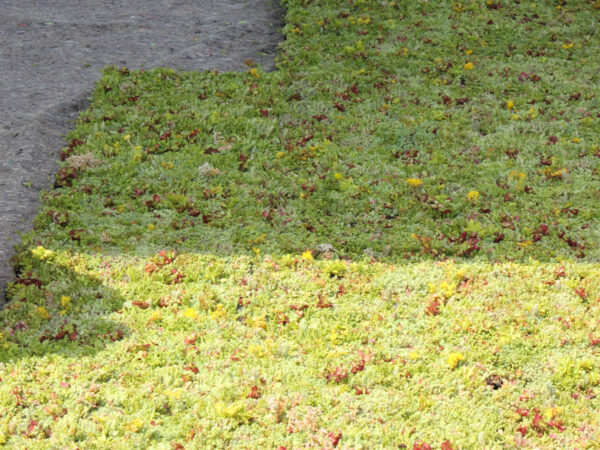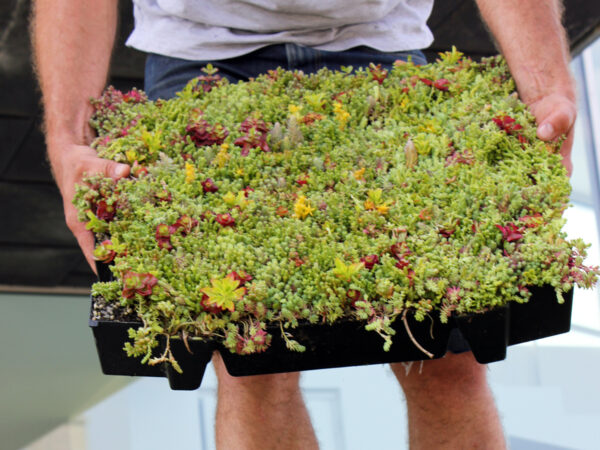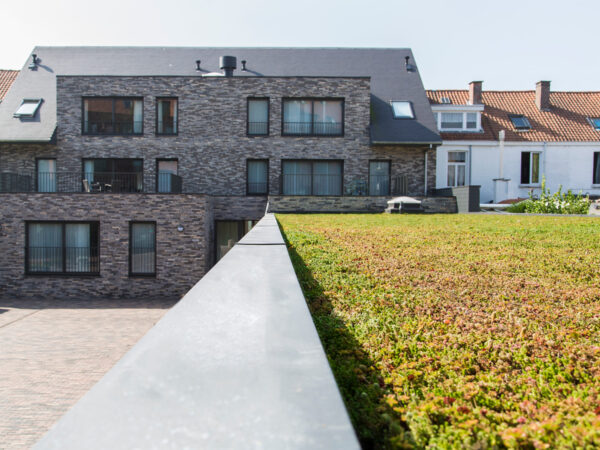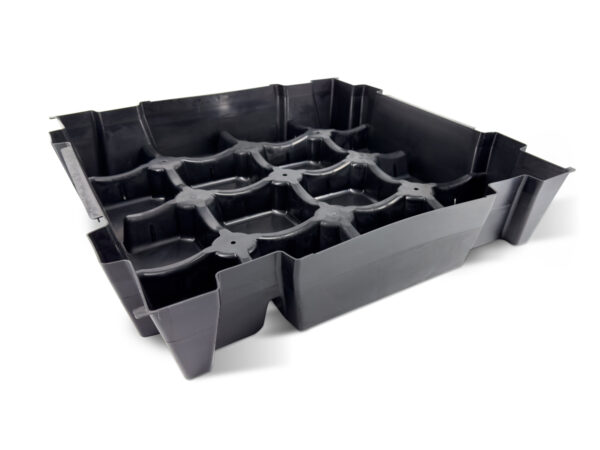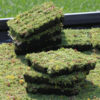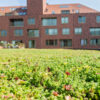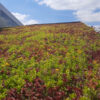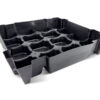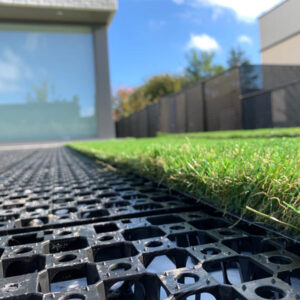Why install a green roof?
“The city of the future is a green city”
Cities are susceptible to the effects of climate change. Weather extremes such as very hot summers and increasingly severe storms lead to flooding, heat problems and poorer air quality. Sustainable spatial planning such as green roofs, for example, play an important role within climate-proof construction. The city of the future is definitely a green city.
A climate-friendly city starts on your roof! Therefore, ECCOsedum cassettes are extremely climate-friendly but also more climate-robust than the average sedum cassette. In fact, normal sedum cassettes are fairly drought-prone, they soon need to be watered during dry periods since the substrate thickness is limited. ECCOsedum cassettes, on the other hand, contain more substrate and are therefore more climate-robust. Unlike most other sedum cassettes on the market, ECCOsedum cassettes are slightly heavier in weight. They sit at 75 to 80 kg/m² when fully saturated with water. Other similar lightweight sedum cassettes weigh only 50 to 55 kg/m². The extra weight comes from the greater water storage capacity of these ECCOsedum cassettes. So not only will you benefit from the cooling effect of sedum cassettes in the summer, but you will also have to water much less quickly than with traditional sedum cassettes.
Water storage
To reduce the increasingly common nuisance caused by heavy rainfall, it is becoming more important to apply water retention to roofs. Research has shown that green roofs can store at least 50% of precipitation in the drainage layer, substrate and vegetation.
Air and water purification
The plants of a green roof filter particulate matter from the air and convert CO2 into oxygen. In this way, green roofs contribute to a better environment through air purification. Green roofs also provide water treatment: because polluted precipitation first flows through a green roof, some of the pollution is filtered out before it enters waterways.
Cooling
Surfaces with plants warm up less quickly and retain less heat. In addition, plants evaporate water, leading to cooling of the air. This creates a cooler and more pleasant urban climate.
Sound insulation
In addition to thermal insulation, a green roof also has a sound-deadening effect. The combination of substrate, plants and the embedded air in the green roof system leads to good sound insulation. Sound waves are collected and reflected. The substrate blocks lower sound waves, while plants block higher frequencies. Consider noise from airplanes and traffic, as well as heavy rain and hailstorms. Green roofs provide a 3dB reduction in sound reflection and up to 8dB of sound insulation. This reduction does not seem like much, but to the human ear a noise reduction of 10dB is a 50% reduction. Sound insulation depends on the thickness of the structure of the green roof.
Higher efficiency solar panels
The efficiency of solar panels on a green roof is up to 16% higher than the efficiency of solar panels on a regular roof.
Solar panels have the highest efficiency at low ambient temperatures. On a black/bitumen roof, for example, the temperature can reach about 60 to 70°C as opposed to only 35°C on a green roof. This greatly increases the efficiency of solar panels. In addition, the lower temperature also reduces wear and tear on the solar panels, so they last longer. In fact, the roofing lasts about 2 to 3 times longer. Biodiversity is also enhanced by solar panels because other plants will establish themselves in the shaded areas under the panels.
Heat-regulating effect
A green roof primarily has a heat-regulating effect. This effect is greatest in summer. With traditional roofing, large fluctuations in indoor temperatures can occur. In summer, a building heats up because a gray roof absorbs the sun’s heat. When a green roof is applied, direct sunlight is reflected by the vegetation rather than absorbed. In addition, the moisture present in the vegetation evaporates, providing additional cooling. This together ensures, that the temperature in the building stays lower and you can save on energy costs for air conditioning.
Visual benefits
A view of greenery has a positive effect on a person’s mood and therefore on a person’s physical health. Moreover, the vegetation varies according to the seasons which provides a pleasant variety in the view.
Longer lifespan for roofing
A green roof lasts longer than regular roofing (even twice as long compared to a flat roof with bitumen covering). The presence of the layer structure protects the roofing against: UV radiation, heating, freezing and temperature fluctuations of the roof surface, uneven heating of the different roof layers and mechanical damage.
Green roofs
ECCOsedum ready-to-use green roof tiles can be installed on both new and existing buildings thanks to their low weight per m². ECCOsedum can also be installed on both flat and pitched roofs. Because of their heat-regulating effect, green roof tiles are also highly suitable for applications in commercial buildings with refrigerated warehouses or air-conditioned buildings.
General presentation placement
Two parameters must be considered when installing ECCOsedum green roofs:
- Preventing leaching or shearing of the substrate
- Shedding of the entire green roof system through the roof slope
For reasons above, a roof pitch cannot be unlimited. For slopes of up to 15°, the system can be installed without additional precautions.
1. Placement of anti-root fabric(ECCO PE400)
Installation of anti-root cloth on the existing roof waterproofing. Depending on the roofing material, an anti-root liner will or will not need to be used. No anti-root foil should be used with EPDM and PVC unless specifically requested by the manufacturer. This is the case with roof waterproofing material consisting of asphalt membranes. The anti-root fabric prevents plant roots from damaging your roof waterproofing. Always seek advice from your roofing material manufacturer.
2. Placing protective layer of ECCOPROTECT 400
Always place the rolls of ECCOprotect 400 with an overlap of 10 cm. For ECCOprotect 400, a non-organic felt cloth is applied to a woven PP fabric (dimensions: 2.1 m x 40 m). This layer consists of a cloth that provides additional protection to the roof membrane from sharp objects. These items could damage the roof during installation. In addition, this provides an additional water buffering layer of about 3 to 4 liters per m².
3. Placement of ECCOSEDUM green roof trays
The trays are held together by a click system and, if necessary, are cut using a saw or grinding wheel. The RHP substrate is held together by the roots of the sedum plants. When cutting, do try to keep the water buffering layer intact by cutting only to half height.
Mutual anchoring
The trays were fitted with recesses and bulges on the sides to prevent them from shifting in relation to each other.
Vertical anchoring
Two lips per tray ensure that all trays are anchored together and cannot blow up. Each tray grabs over the edge of 2 neighboring trays and is in turn held by 2 other trays.
The tiles feature vertical cutouts and emergency spillways so that rainwater not absorbed by the green roof system can drain smoothly.
The tray can be applied to flat and gently sloping roofs with slopes up to 25 degrees. For applications on larger slopes or over lengths longer than 20 meters, a structure will need to be provided to limit splash forces. The advantage of the tray system on sloping roofs is that it is a compartmentalized system; each tray receives the same amount of water so there is a constant in vegetation.
The tray is composed of a drainage layer, a substrate layer with significant water buffering capacity and a vegetation layer.
The buffer volume of the sedum trays in combination with the protective layer is at least 35 liters/m².
Drainage layer
The tiles have a structure designed in such a way that rainwater not absorbed by the green roof system can drain smoothly to drainage points.
The lower drain holes are located 1 cm from the bottom so that even non-capillary water can be stored to a limited extent.
Substrate layer – water buffering layer
The trays are filled to full height (8 cm) with substrate. In some places (near the emergency spillways), the thickness of the substrate is 3.5 cm. Thus, the minimum thickness of the substrate is 3.5 cm – the average thickness is 6 cm.
The substrate layer has several functions: It provides nutrition, oxygen and water to vegetation, as well as it anchors the roots.
ECCOsedum trays are filled with roof garden substrate, composed of lava, pumice and green compost.
Water buffer volume per tray: 32.5 litres/m²
Chip size: 0-12 mm
Volume weight of substrate after compaction in dry condition: 0.78 g/cm³
Volume weight of substrate after compaction at maximum water capacity: 1.27 g/cm³
Vegetation layer:
The pre-cultivated extensive green roof system comes with at least 7 species of sedum plants. The trays are delivered at least 80% densely grown.
Technical Specifications ECCOsedum :
|
FEATURES
|
SPECIFICATIONS
|
| Composition tile |
100% recycled and 100% recyclable PP
|
| Tile dimensions |
49 x 45,5 cm
|
| Height of tile |
8 cm
|
| Weight dry |
11.7 kg/tray – 51.5 kg/m²*.
|
| Weight saturated |
19 kg/tray – 84 kg/m²*
|
| Number of trays per m² |
4.4 units
|
| Water storage capacity |
32.5 liters/m²
|
| Total volume of substrate per tile |
15 liters*
|
*These are theoretical values. In practice, this may vary slightly because the tiles may expand when filled with substrate.
Installation of sedum trays
Installation of a root barrier
Anti-root foil should not always be used with EPDM or PVC unless specifically requested by the manufacturer.
Placing the protective layer
Protective coating is recommended at all times. This is to prevent damage to the roof seal during installation + because of the additional water buffering volume. This cloth should be placed with an overlap of 10 cm.
PROTECT cloth technical data:
Material: Inorganic felt cloth
Weight: 300 g/m²
Height: about 5 mm
Standard roll width: 2.00 m
Water retention capacity: 3-4 l/m²
Installation of the sedum trays
The trays are held together by a click system and are cut using a saw or grinding wheel. The cut side is best placed against the previous tray to reduce the risk of drying out. Any edge areas can be filled with roof gravel.
Maintaining your sedum roof
Although a DIY green roof is low maintenance, an inspection 2x a year is still recommended.
The green roof is walkable for maintenance, not to stay on permanently as a roof terrace. For this, you should provide tiles in wood or concrete.
The following work is required:
-
- Removal of unwanted weeds and tree seedlings (2 times a year)
- Fertilize with the specially formulated fertilizer (once a year, 30 g/m²)
- Removal of weeds from gravel edges.
- Cleaning the rainwater drain



